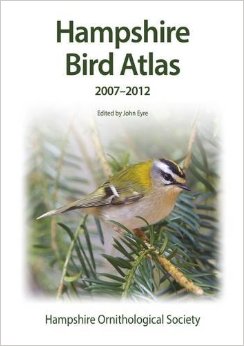
Publisher: Hampshire Ornithological Society
Publication Year: 2015
Binding: 2
Page Count: 448
ISBN Number: 9780956771261
Price: £35.00
Hampshire Bird Atlas 2007-2012
The latest stocktake of Hampshire’s avifauna underlines the significant changes that have occurred within this large and diverse county since the Birds of Hampshire was published back in the early 1990s. With species accounts covering in excess of 200 species, and drawing on data from the national Bird Atlas 2007-11 project, there is a great deal of information packed into the 448 pages.
The large format of the book – the page size is A4 – provides the space for a decent amount of text to provide interpretation of the maps and very occasional tables. The maps present information on breeding distribution and abundance, winter distribution and abundance, and change in distribution since the previous county atlas project. The overlay of differently sized dots (abundance) onto paler coloured squares (distribution) on the whole works well, though assessing abundance patterns is perhaps not as easy as it might have been. The combination of similarly toned reds (distribution loss) and greens (distribution gain) is a poor choice, however, for those affected by the deuteranopia subtype of red-green colour-blindness; the inclusion of ‘+’ and ‘-‘ within the shaded squares may help somewhat.
Ahead of the species accounts is a substantial, highly readable and excellent overview of Hampshire’s habitats, their birds and the patterns of change evident within them. These habitat-based sections are supported by large maps outlining the distribution of the habitat in question; in some instances, different habitat subtypes are shown within the map (e.g. the farmland map splits this habitat type into arable and horticulture, and improved grassland).
One of the most striking patterns within the species accounts is the loss of even quite familiar species from large parts of the county. The disappearance of Grey Partridge will not surprise Hampshire birders but the thinning of Garden Warbler, Sparrowhawk, Little Owl, Meadow Pipit and Swift just might. Losses from parts of the New Forest are particularly striking for some species and one wonders for how much longer the county will retain Wood Warbler, for example. The losses are balanced by a far smaller number of species whose distribution has increased. Firecrest is one of the more interesting of these increasing species.
Appendix II tabulates the breeding codes used to define ‘likely breeding’ – the category delivering the breeding evidence used for the distribution maps. This is useful, particularly because it also includes the dates used to define the breeding season for atlas purposes. It would, however, have benefited from inclusion of the definitions behind the codes presented within the table. The reader is instead referred to page 11 for these codes when repeating them alongside the table would have been preferable. This is a minor quibble as are ones that concern the design and the highly variable quality of the photographs used. Some of the photographs are stunning, being sharp, well-lit and showing unusual poses or behaviours – the Grey Heron with a Sand Martin in its bill, for example. While one expects photographs of scarce visitors to be of a lower standard because they are usually the only available record shots, some of the photographs of common species leave a lot to be desired. The Barnacle Geese on page 61 is perhaps the worst of the out of focus shots, while the Redwing used full bleed on page 357 has clearly been used at a size well beyond what the original image could stand. I mention these faults because the size at which the images have been used underlines that they have been given as much prominence as the text and maps; if you are going to do this, then the images have to be pin-sharp.
I suspect that some of the fault may lay with the designers, WILDGuides Ltd, because there are other aspects of the page design that fall short of the standards one has come to expect of their other excellent publications. These problems centre around a poor paper choice – the paper weight needs to be higher in order to stop material from the back of the pages showing through – and the failure to use the baseline grid correctly – which leaves adjacent columns of text out of alignment with each other and gives the page layout an unbalanced feel.
While one may find the design and images wanting, you cannot fault the information presented or the efforts of the Hampshire Atlas Team who brought the wealth of information and knowledge together. They are to be congratulated. As someone who spent his youth birding in Hampshire, and whose records fed into the latest Hampshire Atlas project, I am delighted to see this excellent finished article.
Book reviewed by Mike Toms
Buy this book




Share this page